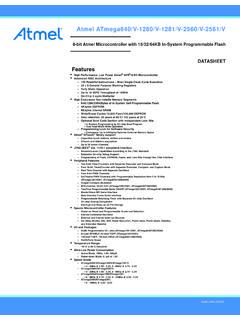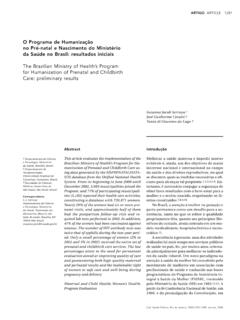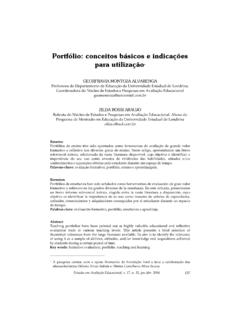Transcription of EMBRYOLOGY - Louis Bolk
1 BOLK S COMPANIONS FOR THE STUDY OF MEDICINEGuus van der Bie MDEarly development from a phenomenological point of viewEMBRYOLOGYE mbryology We would be interested to hear your opinion about this publication. You can let us know at the Louis Bolk InstituteThe Louis Bolk Institute has conducted scientific research to further the development of organic and sustainable agriculture, nutrition, and health care since 1976. Its basic tenet is that nature is the source of knowledge about life. The Institute plays a pioneering role in its field through national and international collaboration by using experiential knowledge and by considering data as part of a greater whole. Through its groundbreaking research, the Institute seeks to contribute to a healthy future for people, animals, and the environment. For the Companions the Institute works together with the Kingfisher number: GVO 01 ISBN 90-74021-29-8 Price 10 (excl.)
2 Postage)KvK 41197208 Triodos Bank 212185764 IBAN: NL77 TRIO 0212185764 BIC code/Swift code: TRIONL 2 UFor credit card payment visit our website at further information: Louis Bolk Institute Hoofdstraat 24 NL 3972 LA Driebergen, Netherlands Tel: (++31) (0) 343 - 523860 Fax: (++31) (0) 343 - 515611 Guus van der Bie MD, 2001, reprint 2011 Translation: Christa van Tellingen and Sherry WildfeuerDesign: painting: Leonardo da VinciEmbryologyEarly Development from a Phenomenological Point of viewGuus van der Bie MDBOLK S COMPANIONSFOR THE STUDY OF MEDICINEBolk s CompanionsEmBryology - 3 About the authorGuus van der Bie MD (1945) worked from 1967 to 1976 as a lecturer at the Department of Medical Anatomy and EMBRYOLOGY at Utrecht State University in the Netherlands. As a family physician since 1976, he has recognized the importance of phenomenology and Goethean science for understanding the human being in health and illness.
3 Next to his practice he stayed involved in teaching medical students at Utrecht State University and physicians, and therapists. In 1998 he was one of the originators of Renewal of Medical Education, a project of the Louis Bolk Instituut to produce a complement to the current biomedical scientific approach of the human 2002 he is a teacher of Complementary Medicine and Medical Humanities at the Medical School of Utrecht State University and teaches anthroposophic medicine at the University of Witten/Herdecke (Germany). He is a member of the Medical Section of the School of Spiritual Science at the Goetheanum, Dornach, the projectThe project Renewal of Medical Education aims to produce Companions that demonstrate how the insights of current biomedical science can be broadened by using the Goethean phenomenological method. This method innovates current concepts and expands the understanding of biochemical, physiological, psychological, and morphological factors in living organisms and their development in time and space, and in health, illness, and therapy.
4 The project is commissioned by the Kingfisher Foundation, which aspires the development, application, and publication of the Goethean phenomenological research method in the widest sense, to complement and innovate the accepted scientific view and research method. BOLK S COMPANIONS FOR THE STUDY OF MEDICINE complement current medical education, specifically disclosing human qualities in the fundamental biomedical sciences of S COMPANIONS FOR THE PRACTICE OF MEDICINE contribute to a scientific phenomenological basis for integrative medicine and integral 6 Acknowledgements 71. Introduction 82. Gametogenesis Morphology Gametogenesis Fertilization Summary and conclusion 133. First week of development Morphology Fertilization Cell membrane continuity Zona pellucida Cell cleavage Compaction Embryopause From fertilization to implantation: a special period of time? The development of twins Summary and conclusion Morphology Goethean aspects 224.
5 Second week of development Morphology Growth Differentiation Metabolism Bilaminar germ disc Summary and conclusions Morphology Goethean aspects 27 Bolk s CompanionsEmBryology - 55. The third week of development Morphology Development of axial symmetry in the germ disc Primitive streak and mesoderm The cylindrical body form, the folding processes Differentiation of the internal organs Summary and conclusions Morphology Goethean aspects 326. Embryonic period Morphology Folding process Process of unfolding Summary and conclusions Morphological considerations Goetheanistic aspects 407. Characterizing four processes of development introduction The physical state of individual development Physical substance in biology Surface and boundary Physiological processes of individualized life and metamorphosis A structure in time Metamorphosis Life processes and consciousness Consciousness, physiology, and reflexes Psycho-neuro-pharmacology A relation between the inner and outer world Consciousness, behavior and determinism 478.
6 Four qualities in early development: morphodynamics General aspects Relation between center and periphery Morphodynamics in the first phase Morphodynamics in the second phase Morphodynamics in the third phase Morphodynamics in the fourth phase 539. Synopsis Phases of development 55 Literature 57 PrefaceIn his book Lifelines Steven Rose states: The challenge to the opponents of biological determinism is that, while we may have been effective in our critique of its reductionist claims, we have failed to offer a coherent alternative framework within which to interpret living processes. We have the same challenge with regard to morphology and EMBRYOLOGY . It is imperative to offer a satisfactory alternative framework. In trying to remedy this problem we have striven for to reach two goals: first, to indicate an alternative framework in morphology, and second, to show that the alternative framework which characterizes dynamic quality in morphological phases opens new possibilities for interpreting morphological processes.
7 We achieved the characterization of the dynamic quality in morphological phases by using a phenomenological approach to morphology, and then interpreting this with the help of Goethean science. We think a new framework will be helpful if it can be shown to refer to functional entities in biology. In this case, many facts and details can be seen in a context and understood as belonging to recognizable phases of development. We chose the dynamic quality in morphological phases for this purpose since it allows us to see coherence in the facts. The dynamic quality in morphological phases can be shown to refer to functional processes in results in new concepts in morphogenesis. These new concepts recapture an understanding of morphogenetic factors in living organisms and their development in time and space. This gives us, for instance, a possibility of understanding the relation consciousness and behavior to the shape of the hope that this framework will be helpful for medical students, who have to learn and remember many morphological has taught us that an overview of the whole makes remembering the details easier.
8 We present this module in an effort to aid medical students and others to take in the wonderful world of EMBRYOLOGY and remember it better in later study and want to emphasize that this module does not replace the textbook on EMBRYOLOGY . The information in the module is compact and presupposes the knowledge contained in regular textbooks. Morphogenetics is the study of how form and shape developBolk s CompanionsEmBryology - 7 AcknowledgementsThis module in the series BOLK S COMPANIONS FOR THE PRACTICE OF MEDICINE was written at the Louis Bolk Instituut, Driebergen Holland. It is a result of the stimulating exchange of ideas with my colleagues W. Schad, Chr. van Tellingen, G. Verhaagen, H. V gler, J. van der Wal and R. Zech. I am most grateful to them for their valuable comments, and I am glad we are not at the end of this exciting journey. The next subject to be studied is organogenesis. I hope our cooperation in studying organogenesis will be equally project was made possible financially by gifts from Iona Stichting, Stichting Phoenix, Pharma Natura (S.)
9 Africa), Stichting ter Bevordering van de Heilpedagogiek, Stichting Triodos and Kelly van der Bie MD, Driebergen April IntroductionEarly development in human embryologyEmbryonic development can be divided into different developmental phases. Like every biological developmental process, embryological development is a process in time and as such the visible stages appear as a continuous process in time. Stages and phases are in fact artificially produced by the observer. Therefore, the observer has to be aware of the criteria he or she uses in differentiating the various we look at the developing plant, for instance, it can be seen to grow according to a particular time pattern which is structured by morphological and functional changes. We classify its phases based on these morphological and functional term phase is used to define and describe a time period during which a particular process takes place.
10 In plant-life, for instance, we can discern germinating, growing, and flowering as clearly different processes and we use a particular term for each phase. Each process (germinating, growing, and flowering) represents a particular aspect of plant development resulting in particular plant products or plant , the differentiation of phases is not just a result of observation, it also has a counterpart in the process of conceptualization in the human mind: we recognize a group of phenomena as belonging to a particular process. The changes in the described processes determine whether development is at one phase or another, and visible phenomena belonging to certain stages can be seen as belonging to one larger develop-mental phase. A phase therefore may cover different we shall try to find the characteristic features of different phases in EMBRYOLOGY by using Goetheanistic phenomenology as a scientific approach: morphological and biological phenomena in different organisms are studied and compared in order to find out what the characteristics of their relationships are, what they have in common and how they are different.





